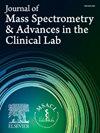Enhanced identification of Morganella spp. using MALDI-TOF mass spectrometry
IF 3.4
4区 医学
Q2 MEDICAL LABORATORY TECHNOLOGY
Journal of Mass Spectrometry and Advances in the Clinical Lab
Pub Date : 2025-05-03
DOI:10.1016/j.jmsacl.2025.04.011
引用次数: 0
Abstract
Introduction
The genus Morganella, including clinically isolated species M. sibonii and M. morganii, has a still underexplored role in clinical microbiology. Despite the clinical relevance of Morganella spp., current MALDI-TOF commercial systems fail to differentiate these species. Whole genome sequencing (WGS) remains the most effective method to distinguish species. However, this method is not adapted for routine lab workflow. Enhancing MALDI-TOF’s accuracy could make it a rapid and effective approach for distinguishing Morganella species in routine laboratory diagnostics.
Objectives
This study aims to improve the performance of MALDI-TOF for identifying Morganella spp. using WGS as the gold-standard reference method.
Methods
We applied Machine Learning (ML) algorithms to a collection of 235 clinicial Morganella spp. strains to develop an optimized identification model. Whole genome sequencing was used to characterize these strains and perform phylogenetic analysis, categorizing 209 strains as M. morganii and 26 as M. sibonii.
Results
The ML-based classifiers showed improved identification accuracy (44 of the 160 designed with accuracy at 1). Also, MS analysis identified 11 peaks able to discriminate between M. morganii and M. sibonii.
Conclusion
Through development of a publicly-available online ML-based classifier, this study has improved the capacity of MALDI-TOF for distinguishing Morganella spp., providing a reliable, user-friendly solution suited to routine clinical diagnostics and supporting a better understanding of the roles of M. morganii and M. sibonii in human pathology.
MALDI-TOF质谱法对摩根菌的强化鉴定
摩根氏菌属,包括临床分离种M. sibonii和M. morganii,在临床微生物学中的作用尚未得到充分的探索。尽管摩根菌属具有临床意义,但目前的MALDI-TOF商业系统无法区分这些物种。全基因组测序(WGS)仍然是区分物种最有效的方法。然而,这种方法并不适用于常规的实验室工作流程。提高MALDI-TOF的准确性可使其成为实验室常规诊断中快速有效的莫氏菌种类鉴别方法。目的以WGS为金标准参比法,提高MALDI-TOF鉴别摩根氏菌的性能。方法采用机器学习(ML)算法对235株临床摩根氏菌进行筛选,建立优化的鉴定模型。利用全基因组测序对这些菌株进行鉴定并进行系统发育分析,其中209株为莫氏分枝杆菌,26株为西伯利亚分枝杆菌。结果基于ml的分类器具有较好的识别精度(160个分类器中有44个的识别精度为1)。此外,质谱分析还鉴定出11个峰可以区分M. morganii和M. sibonii。通过开发一个公开可用的基于ml的在线分类器,本研究提高了MALDI-TOF区分摩根氏杆菌的能力,提供了一个可靠的、用户友好的解决方案,适合常规临床诊断,并支持更好地了解摩根氏分枝杆菌和西伯利亚分枝杆菌在人类病理中的作用。
本文章由计算机程序翻译,如有差异,请以英文原文为准。
求助全文
约1分钟内获得全文
求助全文
来源期刊

Journal of Mass Spectrometry and Advances in the Clinical Lab
Health Professions-Medical Laboratory Technology
CiteScore
4.30
自引率
18.20%
发文量
41
审稿时长
81 days
 求助内容:
求助内容: 应助结果提醒方式:
应助结果提醒方式:


